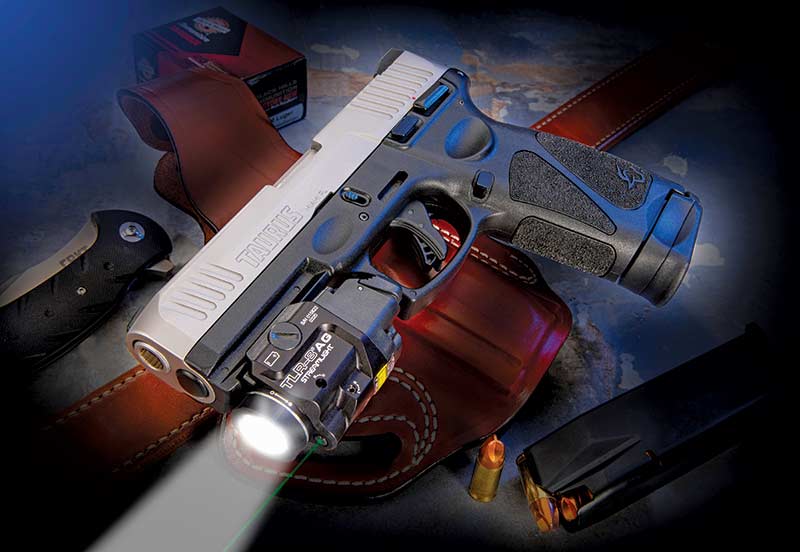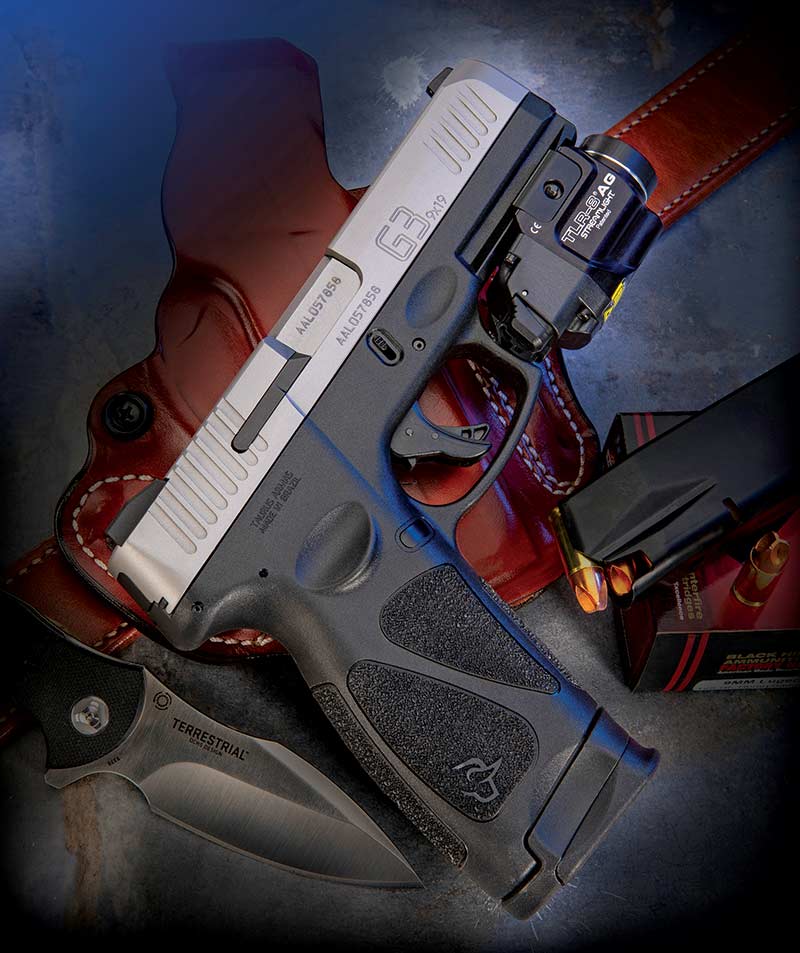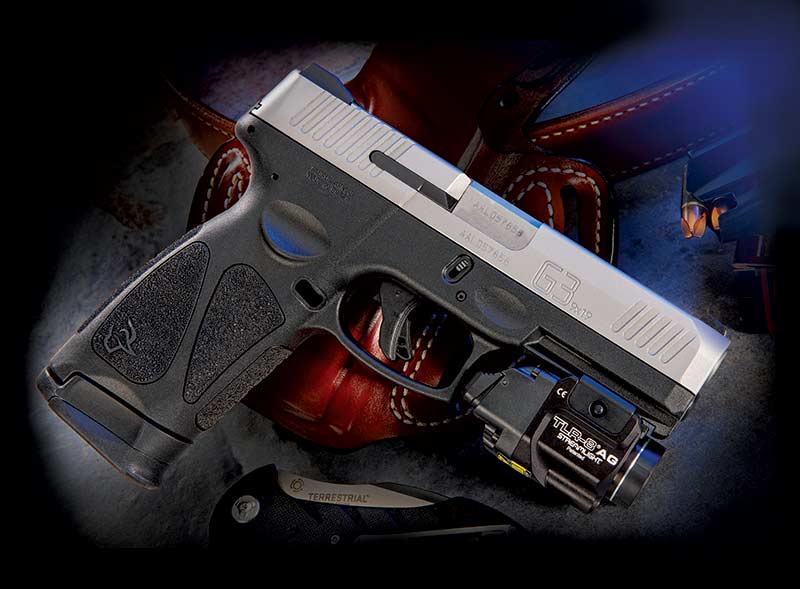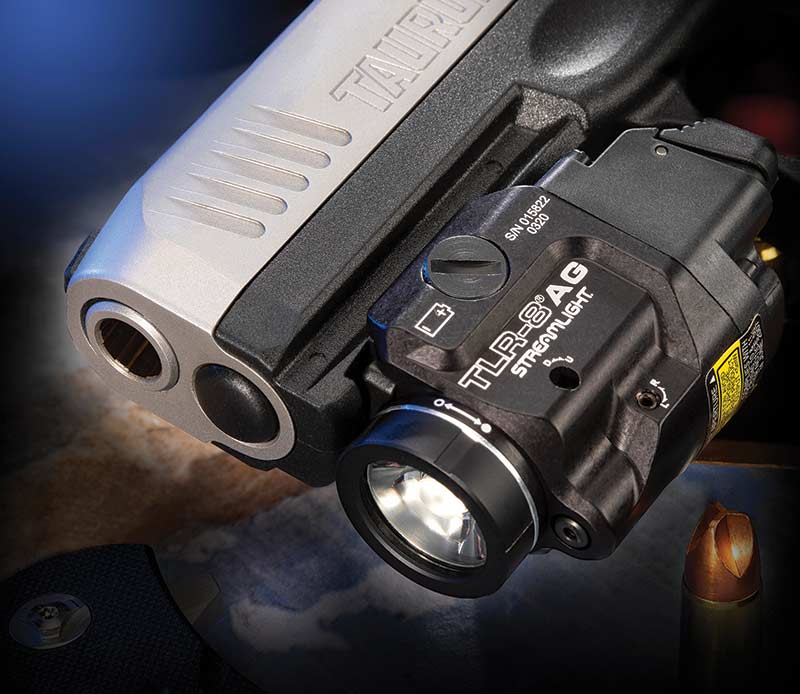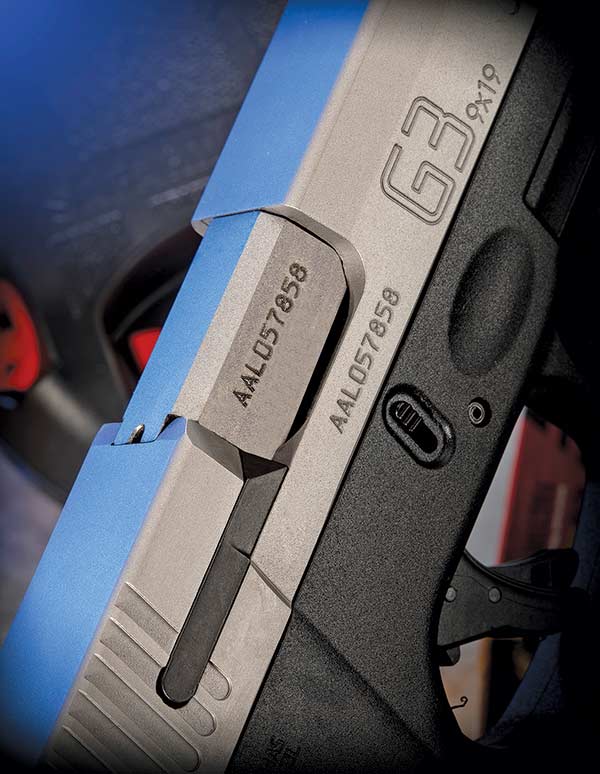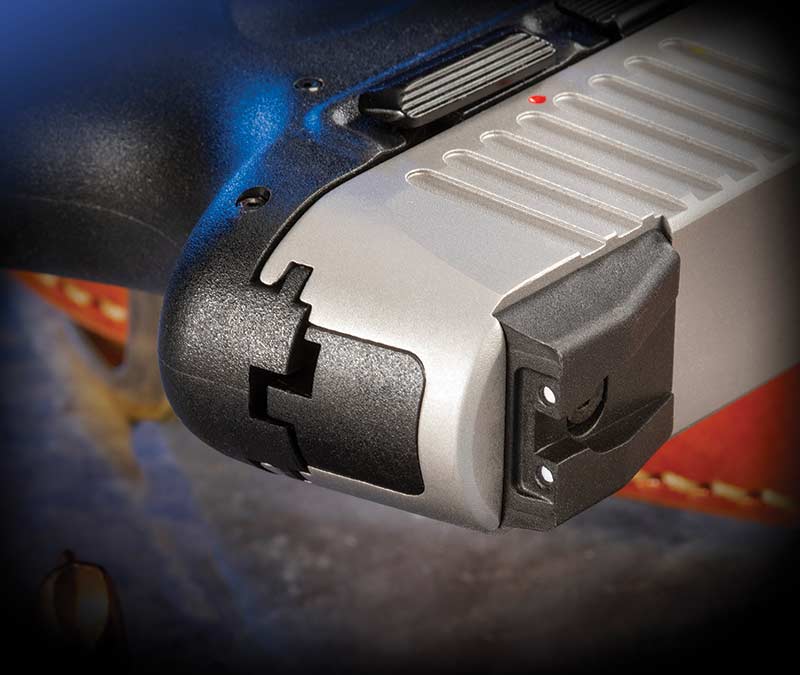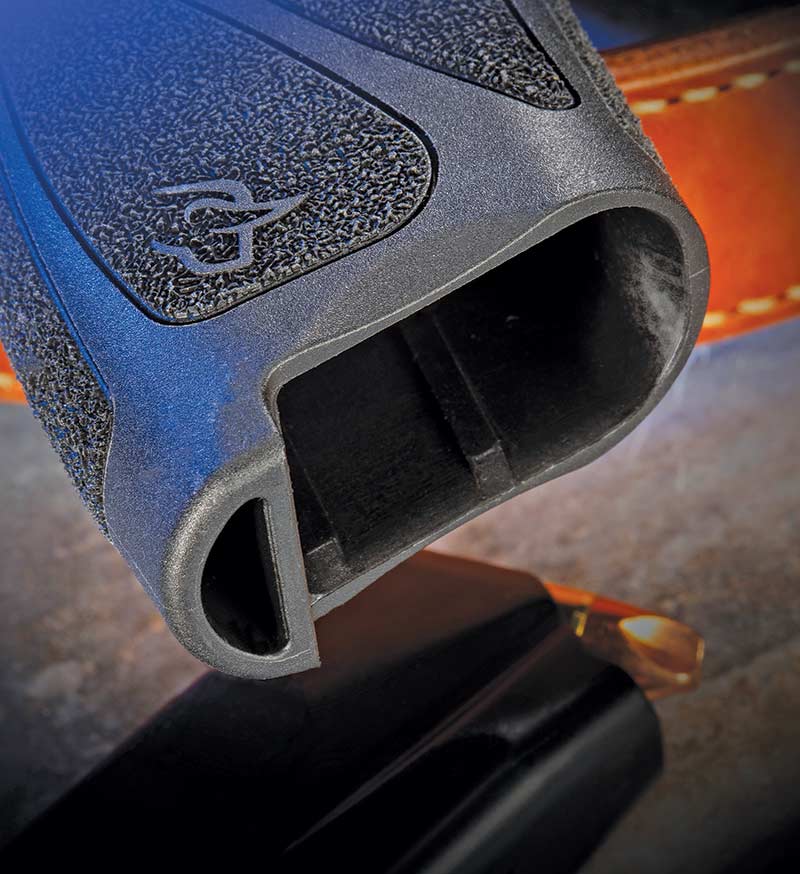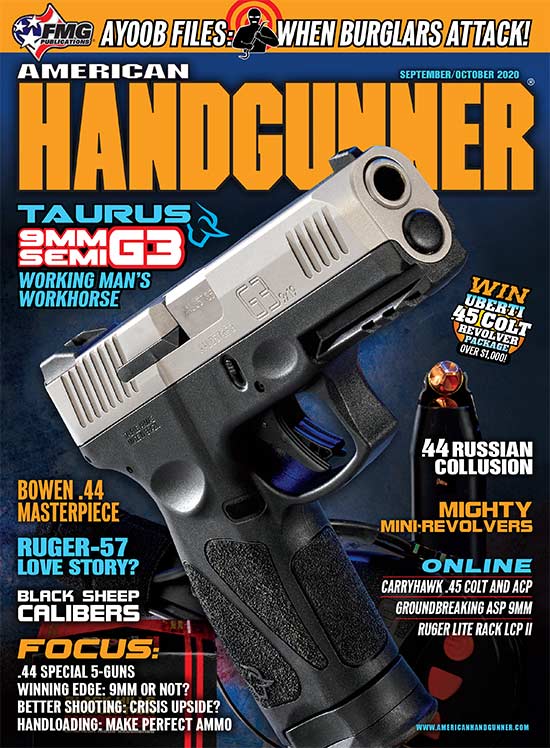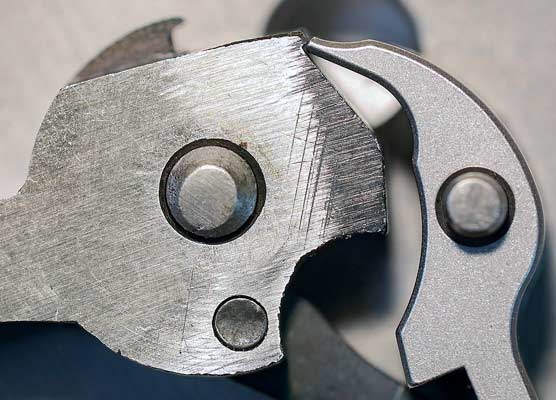Taurus G3 9mm
A Working Man's Workhorse
Sometimes we at Handgunner take a little heat for highlighting guns requiring a letter of credit from a Swiss bank to buy. I get it. Seeing expensive guns made of unobtainium feels like watching someone else scarf down a bone-in ribeye served on a sizzling steel plate — with a side of Brazilian rolls dripping with butter. On the other hand, it’s fun to see and learn about top-shelf products, even if they don’t rank equally with luxuries like food, water and electricity on the family budget. I’ll drool over pictures of a Bugatti Veyron any day of the week even though the odds of me owning one are about the same as Nancy Pelosi speaking at the next NRA Annual Meeting.
Whether or not you’re in the frustrated “it’s out of my reach” camp, we’ve got some delightful news for you. This issue’s cover feature is an eminently affordable gun with a manufacturer’s suggested retail price starting at just $327.98. Why the 98 cents? My guess is they’re trying to undercut all those models tagged with a “.99” price suffix. We’ll have to see if this bold strategy pays off! I’m just kidding — I’m always happy to save two cents here and there. It adds up, you know.
So, what is this gun I’ve seen brand-new on the streets for about $250? The Taurus G3 polymer-framed striker-fired pistol.
You’re probably familiar with the company’s more popular handguns like the Millennium Series, PT-24/7, Spectrum, Judge, Raging Bull and a slew of other pistols and revolvers.
Familiar Classics?
The story of successful gun companies emerging from some material or fabrication expertise in an unrelated field is not new. Gaston Glock didn’t know diddly squat about guns but did know a thing or two about materials and engineering. Seeing an opportunity for a fresh approach, the GLOCK pistol was born — you know the rest of the story.
Taurus shares a similar story. Founded in Porto Alegre, Brazil back in 1939 and known officially as Forjas Taurus (Taurus Forge) the company manufactured tools and dies until its first revolver offering in 1941 — the Model 38101SO.
Over its history, the company developed some interesting partnerships, resulting in a flood of classic guns offering similar, and near identical designs, at more affordable price points.
In 1970, mega-conglomerate Bangor Punta, then owner of Smith & Wesson, bought a controlling interest in Taurus. As sister companies, S&W shared American gun designs while Taurus contributed design, manufacturing and fabrication experience. The partnership produced a series of handguns like the Model 82 six-shot revolver, a close mirror of the popular S&W Model 10.
Enter Beretta. In 1974, the Italian gunmaker won a contract to produce pistols for the Brazilian military — with certain conditions. Beretta was required to open a factory in Brazil and use local labor. By 1980, the contract was complete. Meanwhile, the current ownership of Taurus had purchased the Taurus brand and assets back from Bangor Punta. Seeing opportunity, Taurus bought the Beretta plant, tooling and designs, also neatly inheriting an experienced workforce skilled at building Beretta pistols. Soon, Taurus offered the PT-92 and PT-99 — solid guns at affordable prices.
Like the rest of us, Taurus went through some interesting times. Teenage rebellion? Resisting the status quo? Growing pains? Perhaps …
After a struggle with pricing and quality control, in the earlier 2000 era, the company regained its footing by boosting quality control and trimming prices to provide value to the American gun buyer.
You might remember some interesting handguns hitting the market a few years back in an attempt to establish an “innovator” reputation. The Curve and Model 85 View revolver come to mind. This gimmick phase included bent pistols and cartoon-like revolvers sporting a thumb-sized grip combined with a cylinder the size of a 55-gallon drum. I didn’t much care for stuff like this but then again, I don’t much care for Dippin’ Dots even though lots of other people love them. To each his own, I suppose. Love them or hate them, the new offerings nonetheless earned plenty of exposure for the company.
Since then the company has marched steadily onward, introducing new models like the G2 and G3 series while moving to a new home in Bainbridge, Georgia.
The G3 Walking Tour
The G3 is a polymer, striker-fired pistol available in nine different varieties. Choose from all black, two-tone with matte stainless slide, or different frame colors including tan, gray or green. The other offerings vary by different magazine capacities. You can order the G3 with two 10-rounders, two 15-rounders or a 15- and 17-round magazine.
I love the feel of the frame. No, it doesn’t come with replaceable grip panels — that’s one of the sacrifices you make for the very sweet price point of this pistol. The molded-in grip texture — front, back and sides — feels like skateboard tape. It’s low profile, so it won’t gouge your waistline if you carry inside the waistband but offers great hand purchase. I had no trouble keeping this pistol stable in my hand during rapid fire strings. You’ll also find thumb recesses for your firing hand on both sides of the frame — a nice touch — so you lefties can’t complain about discrimination there. My firing hand thumb knuckle rides there comfortably and helps me get a consistent grip placement when I pick up or draw this pistol.
The magazine release arrives in the right-hand configuration but is reversible. The slide lock lever lives permanently on the left side. The only other controls are the disassembly levers. They operate somewhat like those on a GLOCK. When you pull both levers down the slide will unlock and slide off the front of the frame.
The G3’s sights are standard 3-dot variety. The front is screwed into the slide, like a GLOCK front sight, while the rear is dovetail mounted and adjustable for windage.
Double Trouble
I have two identical G3s sitting on my desk, one of which is the 2-tone model with matte stainless slide. That one retails for a bit more, $360.70. Factory specs show the trigger weight should be 6 lbs., but I measured a bit less. The all-black pistol averages 5 lbs., on the nose, while the 2-tone model averages 5.25 lbs.
If second strike capability is on your “must-have” list, you’ll be happy to know the G3 has it. If you hear a “click” instead of a “bang” you can simply press the trigger again. As there is no partial cocking happening from the slide movement, it takes a bit more force — about 7 lbs. This is a “your mileage may vary” feature. Some people love it, and some don’t care. I fall into the ambivalent camp as my default action on hearing a “click” is to start the tap-rack drill. The G3 gives you the choice.
The trigger has a leaf safety in the blade and will only move through part of the take-up stage unless it’s firmly depressed. Overall take-up travel is about 1/2″. The travel is grit free, especially after shooting a few dozen times. Once you hit resistance, you’ll feel steady pressure for about 1/8″ of travel until it breaks. The break sensation is a little mushy, but it’s a perfectly usable service pistol trigger, especially considering the price.
If you’re into shooting the reset, you’ll get just over 1/4″ of forward travel before you feel and hear a distinct click.
Safety First
The G3 comes equipped with a manual safety lever on the left side of the frame. A flick up with your firing hand engages it with an unambiguous click. Reverse the sequence to fire. It’s not likely to go anywhere against your will.
Besides the aforementioned trigger leaf safety, there’s also an internal firing pin block. Located in the slide guts, this steel button prevents the striker from moving forward to make contact with a cartridge. The only time it’s out of the way is when you press the trigger. The motion raises the block and allows the firing pin to move forward.
Taurus also includes what they call a memory pad. While not a mechanical safety device, this frame indentation (on both sides) just above the forward section of the trigger guard provides a natural place to rest your trigger finger. I like this. Sure, we should all work to hard-wire proper finger behavior into our brains, but a little nifty engineering to help build the habit can only be a good thing. It’s subtle, but your finger will have no trouble finding it without peeking.
Workhorse
I shot the living bejeepers out of this pistol to run it through its paces using a wide variety of self-defense and FMJ ammo. It ran and ran and ran — with one exception. The G3 has a short throat area and didn’t care for the Inceptor Round Nose 9mm cartridges. The Inceptor ARX cartridges ran fine, however. Those particular Inceptor RN bullets are fat in the area just above the case mouth and tended to get caught up in the barrel throat area now and then. To be sure I wasn’t looking at some weird anomaly, I repeated the test with the second pistol and experienced the same thing. This is one of those things to just know and file away. It’s also a reminder of the importance of testing the ammo you want to use with your specific gun.
In this case, it falls in the no-big-deal category. It’s an unusual projectile shape compared to every other 9mm on the market, so it didn’t faze me. Considering I shot well over a dozen other types of ammo with no failures of any kind, I’m chalking it up to irreconcilable differences between that specific cartridge and this pistol.
I did use this G3 trial as an opportunity to check out some interesting 9mm ammo.
From Norma, I shot both the Hexagon and MHP. The Hexagon line is an accuracy match load. If you look at the projectiles, you’ll see them scored like an expanding hollow-point. However, expansion isn’t their purpose — those grooves are designed to improve aerodynamic stability. Science! The MHP bullets are a defensive round offering dramatic expansion. The monolithic design makes them light-for-caliber — 108 gr. in this case. The MHP’s delivered virtually no recoil and moved along at 1,146 while the Hexagons left the muzzle at 1,041 fps. Both printed groups in the 3.5″ neighborhood from 25 yards.
HSM Ammunition may just be the biggest ammo manufacturer you’ve never heard of, so be sure to check them out. I used the 115-gr. HP-XTP load. Velocity averaged 1,242 fps while 25-yard groups ran in the 3.4″ range.
I also checked out Black Hills’ 115-gr. EXP (1,165 fps) and the smokin’ 100-gr. HoneyBadger (1,217 fps). The G3 delivered groups in the 3.5″ range for both of those as well
A G3 Compact?
As I write this, a new member of the G3 family is on the way. The new Compact version shares most of the same feature set and comes standard with either three 10- or 12-round magazines. Taurus plans to offer 15- or 17-round magazines as an option, presumably with a magazine sleeve. MSRP of the G3c is set at just $305.74.
Here’s the bottom line. If you need a solid gun that will perform, and at a budget-friendly price point, check out the G3. With a limited lifetime warranty, you’ll get new gun benefits at a used-gun price point.
For more info:

